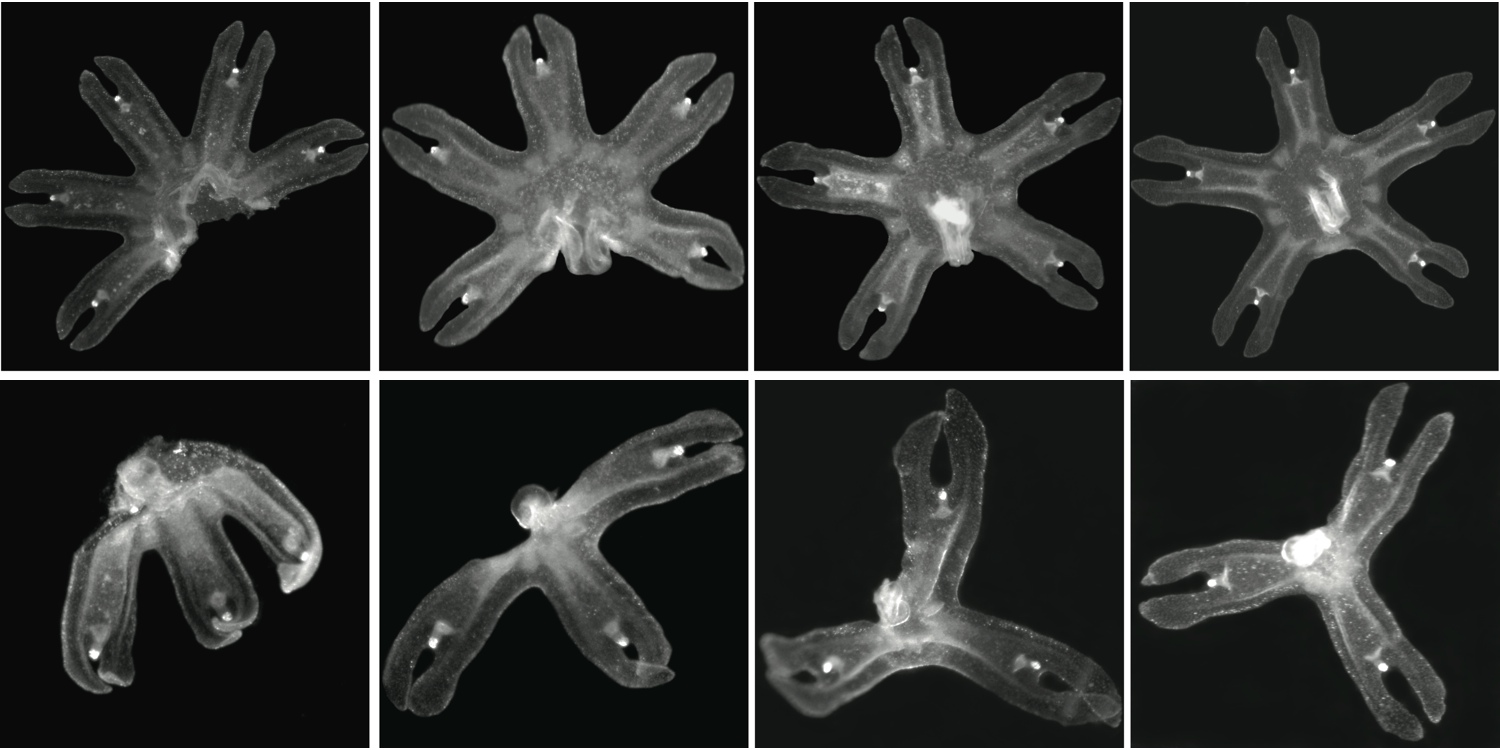In Photos: Moon Jellyfish Can Rearrange Limbs
Delicate saucer-shaped blobs that pulsate their way through the seas, moon jellyfish have a clever trick up their "sleeves," as scientists have found the jellies can self-repair after losing a limb or two. But rather than growing back the injured or amputated arm, moon jellyfish just rearrange their other limbs to keep their bodies symmetrical. Here's a look at such aquatic trickery. [Read full story on moon jellyfish self-repair]
Baby jellies
Juvenile moon jellyfish stay symmetrical no matter how many limbs they lose, new research finds. They do this by using their muscle movements to rearrange their remaining limbs around their bodies, enabling them to keep on swimming. Here, symmetrical jellies sport between two (far left) and eight (far right) limbs. (Photo Credit: Image courtesy Michael Abrams, Ty Basinger and Christopher Frick, California Institute of Technology)
Symmetry is beautiful
Moon jellyfish juveniles becoming symmetrical after the loss of limbs. The top row shows the process of symmetrization after losing four of eight limbs. The bottom row shows the process after losing five of eight limbs. Jellyfish regained their symmetry in a matter of hours to days, researchers reported on June 15, 2015 in the journal Proceedings of the National Academy of Sciences. (Photo Credit: Image courtesy Michael Abrams, Ty Basinger, and Christopher Frick, California Institute of Technology)
Growing up
As long as juvenile jellyfish regained their symmetry, they matured into relatively normal adulthood, albeit with fewer tentacles and stomachs than typical jellyfish (adult moon jellyfish have four gastic pouches).
Get the world’s most fascinating discoveries delivered straight to your inbox.
Image G shows a juvenile jelly that has had three limbs amputated, leaving five behind. The jellyfish regained its symmetry and grew into normal adulthood over the next several weeks. Image H shows another jellyfish that did not manage to become symmetrical. It matured to adulthood, but with a shrunken, misshapen bell and an oversized mouth. Specimens like this one sank to the bottom of the tank and would likely not survive in the wild. (Photo Credit: Image courtesy Michael Abrams, Ty Basinger, and Christopher Frick, California Institute of Technology)
How many arms?
Most juvenile moon jellyfish have eight limbs, arranged symmetrically. On occasion, some of these juveniles naturally develop with different numbers of arms, as seen here. These jellyfish mature to normal adulthood. (Photo Credit: Image courtesy Michael Abrams, Ty Basinger, and Christopher Frick, California Institute of Technology)
Stained jellies
Researchers used special stains to trace cell death and cell birth in the juvenile jellyfish body, thinking that the animals might be growing or shrinking portions of their bodies to push and pull their limbs into a different arrangement. But cell death and cell birth couldn't explain the body changes that jellyfish underwent after amputations. (Photo Credit: Image courtesy Michael Abrams, Ty Basinger, and Christopher Frick, California Institute of Technology)
Jelly experiments
Researchers weren't sure how the jellies were managing to rearrange their bodies so dramatically after an amputation. Experiments revealed that body cells weren't dying or being born at unusual rates — but when the jellyfish were immobilized with muscle relaxers, they failed to regain symmetry, as seen here. In fact, the natural pulsation of the jellyfish muscles pivots the limbs around the body, pulling them into symmetry. (Photo Credit: Image courtesy Michael Abrams, Ty Basinger, and Christopher Frick, California Institute of Technology)
No more pulsating
These juvenile jellyfish have been treated with chemicals that inhibit muscular movement, preventing them from pulsating. The animals did not regain symmetry after losing four of their limbs, and the close-ups show the blunt, amputated ending of their coronal muscle, the ring of muscle that encircles the bell. (Photo Credit: Image courtesy Michael Abrams, Ty Basinger, and Christopher Frick, California Institute of Technology)
A gorgeous swarm
A school of adult moon jellyfish (Aurelia aurita). These common jellyfish can grow more than a foot in diameter and live in oceans around the world. Adults live for mere months, but the jellyfish life cycle is complex: Fertilized eggs become larvae called planula, according to the New England Aquarium. These planula anchor to a surface and develop into anemone-like polyps, which in turn clone themselves and develop into ephyrae. These ephyrae are millimeters in diameter and have eight symmetrical limbs, and are the juvenile form used in the new study. (Photo Credit: R. Gino Santa Maria, Shutterstock.com)
No brain
Moon jellies illustrate how much an animal can do without a brain. These feeders float through the water, catching small prey in their fringelike tentacles, which then pull it toward the central mouth, called the manubrium. The bell provides propulsive action and houses the stomachs and four gonads. (Photo Credit: Alberto Loyo, Shutterstock.com)
Follow Stephanie Pappas on Twitterand Google+. Follow us @livescience, Facebook& Google+.

Stephanie Pappas is a contributing writer for Live Science, covering topics ranging from geoscience to archaeology to the human brain and behavior. She was previously a senior writer for Live Science but is now a freelancer based in Denver, Colorado, and regularly contributes to Scientific American and The Monitor, the monthly magazine of the American Psychological Association. Stephanie received a bachelor's degree in psychology from the University of South Carolina and a graduate certificate in science communication from the University of California, Santa Cruz.











